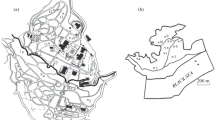Abstract
Ecological-faunistic investigations of the mesofauna were carried out in mountain soils of Ethiopia for the first time. A comparative assessment of the group composition and the structural parameters of soil invertebrate communities was accomplished in a series of mountain habitats on the slopes of an extinct volcano in the altitude range of 1800 to 3200 m a.s.l. Some regularities of the altitudinal changes in the abundance of invertebrates were found: a maximum in a forest on the volcano slope, a trend of reducing their number and mass with altitude, and the minimal abundance of invertebrates in the soils under the forest and on the slope of the volcano crater. In contrast to the mountain systems of southern Europe and Asia, the animal population on the Ethiopian Plateau in the lower positions of the mountain catena was dominated by the forms dwelling on the soil surface; in the forest belt and high mountains, the inhabitants of mineral horizons prevailed. Specific features of the functional structure of the animal population in the soil under the crater forest are its relations to open habitats. At the same time, the absence of faunistic exchange with the adjacent ecosystem of the alpine meadow allows suggesting that the soil animal communities in the crater and on the external volcano slopes were formed independently from one another.
Similar content being viewed by others
References
V. N. Beklemishev and I. A. Chetyrkina, “Biology of Flood. The Destin of Earthworms during the Spring Flood,” in Problems in Ecology and Biocenology (OGIZ, Leningrad, 1935), issue 1, pp. 120–136 [in Russian].
Quantitative Methods in Soil Zoology, Ed. by B. R. Gilyarov and B. R. Striganova (Nauka, Moscow, 1987) [in Russian].
P. Duchaufour, Precis de pedologie, Masson and Cie, Paris, 1965, 2nd ed.; Duchaufour, P., L’evolution des sols, Masson and Cie, Paris, 1968.
I. K. Lopatin, Basic Zoogeography (Vysheishaya Shkola, Minsk, 1980) [in Russian].
A. E. Magguran, Ecological Diversity and Its Measurement, London: Croom Helm, 1988.
K. K. Sent-Iler, “Observations of Soil Fauna in the Suburbs of Voronezh,” Tr. Voronezh. Gos. Univ., No. 10, 3 (1938).
B. R. Striganova, “Distribution of Millipedes (Myriapoda, Diplopoda) in Mixed Forests of Northern Caucasus and Their Role in the Degradation of Forest Litter,” Zool. Zh. 48(11), 1623–1628 (1969).
B. R. Striganova, G. Gebries, and L. B. Rybalov, “Effect of the Agricultural Development of Dry Savanna Lands on Soil Animals in Equatorial Africa,” Izv. Akad. Nauk, Ser. Biol., No. 3, 341–348 (1995).
B. R. Striganova and N. G. Loginova, “Role of Diplopoda in the Biological Cycle of Alpine Meadow Ecosystems in the Little Caucasus,” Zh. Obshch. Biol. 45(2), 196–202 (1984).
Ch. Alluaud, “Entomological Expedition to Abyssinia 1926–1927. Coleoptera, Carabidae,” Ann. Mag. Nat. Hist. 19((10)), 272–287 (1937).
P. Basilewski, “Coleoptera, Carabidae. Mission zoologique de L’I.R.S.A.C. en Afrique orientale LX,” Ann. Mus. Roy Afr. Centr., Tervuren (Ser. 8) Sci. Zool., No. 107, 48–337 (1962).
P. Basilewsky, “Les Plocamotrechina d’Ethiopie,” Rev. Zool. Afr. 88, 148–158 (1974).
H. Franz, Okologie der Hochgebirge (Ulmer Verl, Stuttgart, 1979).
O. Hedberg, “The High Mountain Flora of the Galama Mountains in Arussi Province, Ethiopia,” Webbia 26, 101–128 (1971).
O. Hedberg, “Studies of Adaptation and Specialization in the Afro-Alpine Flora of Ethiopia,” Boisseria 24, 71–74 (1975).
M. S. Mani, Ecology and Biogeography of High Altitude Insects, Series Entomologica, Vol. 4 (Junk, The Hague, 1968).
L. B. Rybalov, “Comparative Characteristics of Soil Macrofauna in Some Tropical Savannah Communities in Equatorial Africa: Preliminary Results,” Trop. Ecol. 3, 1–11 (1990).
L. B. Rybalov, “Soil Animal Population of Natural and Anthropogenic Ecosystems of the Baro-Akobo Interfluve,” in Ecological and Faunistic Studies in Ethiopia, Part 2 (ESTC, Addis-Ababa, 2000), pp. 24–49.
B. R. Striganova, “Dispersion Patterns of Diplopods and Their Activity in the Litter Decomposition in the Carpathian Foothills,” in Progress in Soil Zoology (Vieweg, Braunschweig, 1975), pp. 167–173.
B. R. Striganova, “Ecological Adaptations of Diplopoda to Highland Conditions,” in Advances in Management and Conservation of Soil Fauna (New-Delhi, 1992).
B. R. Striganova, “Peculiarities of the Animal Population in Mountain Forest Soils of the Northern Tien Shan,” Abstr. Bot., No. 12, 39–47 (1989).
B. R. Striganova and L. B. Rybalov, “Soil Fauna of the Dry Savanna and Agrocenoses of the Abyssinian Upland of Ethiopia,” in Ecological and Faunistic Studies in Ethiopia, Part 2 (ESTC, Addis-Ababa, 2000), pp. 50–62.
Author information
Authors and Affiliations
Additional information
Original Russian Text © B.R. Striganova, L.B. Rybalov, 2008, published in Pochvovedenie, 2008, No. 7, pp. 861–870.
Rights and permissions
About this article
Cite this article
Striganova, B.R., Rybalov, L.B. Altitude-related changes in the mesofauna structure in soils of the Ethiopian plateau. Eurasian Soil Sc. 41, 759–767 (2008). https://doi.org/10.1134/S1064229308070107
Received:
Published:
Issue Date:
DOI: https://doi.org/10.1134/S1064229308070107



